Whether you eat plant-based for health reasons or vegan for ethical reasons you’re bound to hear the same question from concerned family and friends, “Where do you get your plant-based protein?” If you hear the question often enough you may begin to wonder yourself if you’re getting enough protein from your diet.
THIS COMPLETE GUIDE PROVIDES:
- TWO different methods for calculating protein needs
- An extensive list of high quality plant-based protein sources
- Answers to “frequently asked questions”
Armed with this information, you’ll be confident that your plant-based diet is meeting your nutritional needs, and you can put your friends and family at ease. AND the best part is, it isn’t that hard!

How much protein do you actually need?
Here’s everything you need to know about the official protein recommendations based on body weight. You can scroll down to find the calculator.
The Food and Nutrition Board within the Institute of Medicine sets the standards. They determined that the Estimated Average Requirement (EAR)* for protein is 0.66 grams per kilogram of body weight. Since some folks aren’t efficient at utilizing dietary protein, they rounded up when setting the Recommended Dietary Allowances (RDAs).**
The RDA was set at 0.8 grams per kilogram for adults. It was determined that women in their second half of pregnancy require more, 1.1 grams per kilogram of body weight, and nursing women require 1.3 grams per kilogram of body weight. Children have different requirements (see Protein RDA Download for more info).
Protein needs based on body weight in pounds (and kilograms)
Adults | Women in Second Half of Pregnancy | Nursing Women |
0.36 grams per pound of body weight | 0.55 grams per pound of body weight | 0.59 grams per pound of body weight |
For example, a 145 lb. adult would require 52 grams of protein (145 x 0.36 = 52).
* EAR is the average daily nutrient intake level estimated to meet the requirements of half of the healthy individuals in a group.
** RDA is the average daily dietary intake level sufficient to meet the nutrient requirements of nearly all (97–98 percent) of healthy individuals in a group
Protein Calculator (adults)
At this point are you overwhelmed with information? Don’t worry, just use this calculator to determine how many grams of protein you need each day based on body weight 🙂
Calculating protein using the 10% rule
You can also determine your protein requirements using the 10% rule, which is more in line with what’s suggested by Dr. T. Colin Campbell from the Center for Nutrition Studies. Dr. Campbell, as you may know, conducted the renowned China study and wrote a book by the same name. He coined the term whole-food plant-based nutrition.
What is the 10% Rule?
It’s easy – approximately 10% of your daily calories should come from protein.
Per the Food and Nutrition board within the Institute of Medicine, the Acceptable Macronutrient Distribution Range (AMDR) for overall protein needs are between 10% to 35% of your daily caloric requirements. Yes, 10% is on the lower end of their guidance; however, as discussed in the frequently asked questions down below, there are health advantages to staying on this lower end.
Per Dr. T. Colin Campbell, the standard American omnivore diet contains about 17% protein.
I provide a calculator that does all of the work for you. But if you want to manually calculate using the 10% rule, here are the steps.
- Determine your daily caloric requirement.
- Multiply your daily caloric requirement by 10%, so you know how many protein calories should be consumed each day.
- Since there are 4 calories in each gram of protein, divide the number of protein calories by 4 to determine how many grams of protein should be eaten each day.
For example, if your body requires 1800 calories, it requires 180 protein calories (1800 x 10%).
180 protein calories would equal 45 grams of protein (180 ÷ 4).
Protein Calculator Using the 10% Rule
Start by calculating your daily caloric needs (please note that your caloric needs may be different if you are pregnant or nursing).
Then input that figure into the Protein Calculator to calculate your daily protein needs based on the 10% rule.
What percentage of protein do plant foods contain?
In nature’s infinite wisdom, plant foods contain an average of 10% protein! So if you are eating a varied whole-food plant-based diet you are automatically getting an adequate amount of protein – plus all of the other macronutrients, micronutrients, and phytonutrients that your body needs. Great news indeed!
Don’t stress over how much protein you are getting each day. Just make sure you are getting enough calories and eating a varied whole-food plant-based diet (not a junk food vegan diet!).
Protein Content of Plant Foods
Here are lists of high quality plant foods. The amount of calories, grams of protein, and percentage of calories from protein have been calculated. As you can see, most foods contain at least 10% of calories from protein as previously discussed. How convenient 🙂
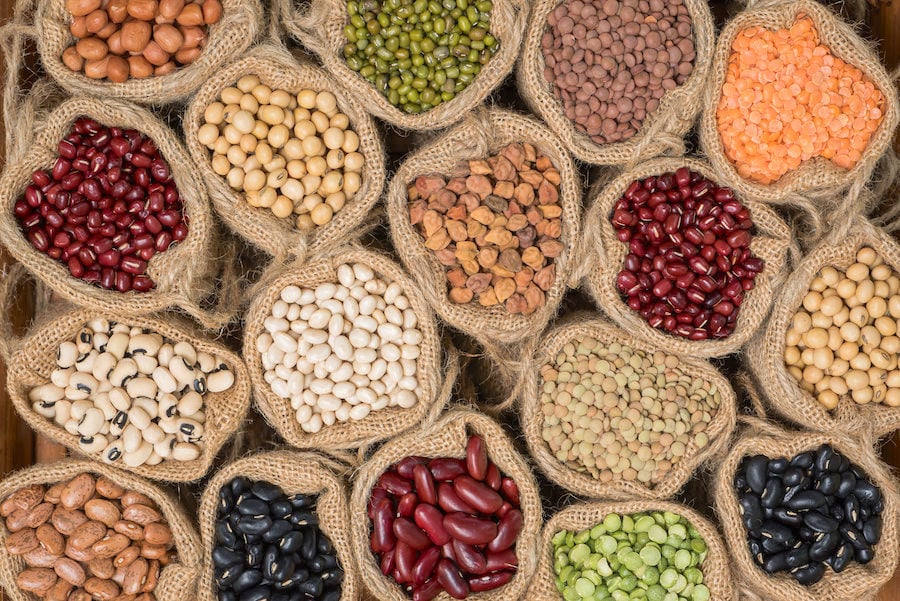
Legumes | Calories | Grams of Protein | % of Calories from Protein |
Black beans, cooked (1 cup) | 240 kcal | 15.13 g | 25.2% |
Cannellini beans, cooked (1 cup) | 249 kcal | 17.42 g | 28% |
Garbanzo beans, cooked (1 cup) | 260 kcal | 13.9 g | 21% |
Hummus, plain (1 cup) | 218 kcal | 5.98 g | 10.9% |
Kidney beans, cooked (1 cup) | 225 kcal | 15.35 g | 27.2% |
Lentils, cooked (1 cup) | 230 kcal | 17.86 g | 30% |
Mung beans, cooked (1 cup) | 212 kcal | 14.18 g | 26.7% |
Pinto beans, cooked (1 cup) | 245 kcal | 15.41 g | 25.2% |
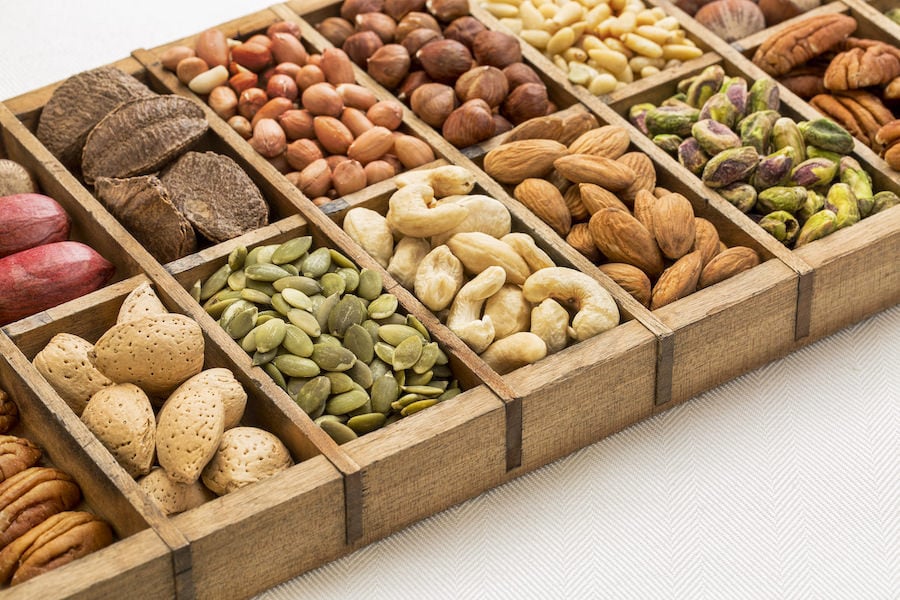
Nuts and Seeds | Calories | Grams of Protein | % of Calories from Protein |
Almonds, raw (1/4 cup) | 160 kcal | 6 g | 15% |
Almond butter (1 Tablespoon) | 95 kcal | 3.5 g | 14.7% |
Brazil nuts, raw (3 nuts) | 100 kcal | 2 g | 8% |
Cashews, raw (1/4 cup) | 160 kcal | 5 g | 12.5% |
Chestnuts, cooked (4 nuts) | 72 kcal | 1.6 g | 8.9% |
Chia Seeds, 1 Tablespoon) | 70 kcal | 2 g | 11.5% |
Hazelnuts, raw (1/4 cup) | 212 kcal | 5 g | 9.5% |
Hemp hearts, shelled (1 Tablespoon) | 57 kcal | 3.3 g | 23% |
Macadamia nuts, raw (1/4 cup) | 241 kcal | 2.65 g | 4.4% |
Peanut butter, unsweetened (2 Tablespoons) | 210 kcal | 9 g | 17% |
Peanuts, raw (1/4 cup) | 207 kcal | 9.42 g | 18% |
Pecan halves, raw (1/4 cup) | 190 kcal | 3 g | 6.3% |
Pine nuts, raw (1/4 cup) | 227 kcal | 4.62 g | 8.1% |
Pistachios, raw (1/4 cup) | 172 kcal | 6.2 g | 14.4% |
Pumpkin seeds, raw (1/4 cup) | 157 kcal | 8 g | 20% |
Sesame seeds, raw (1 Tablespoon) | 52 kcal | 1.6 g | 12.3% |
Sunflower seeds, raw (1/4 cup) | 250 kcal | 9 g | 14.4% |
Tahini, raw, stoneground (1 Tablespoon) | 86 kcal | 2.67 g | 12.4% |
Walnuts, raw (7 halves) | 93 kcal | 2.16 g | 9.3% |
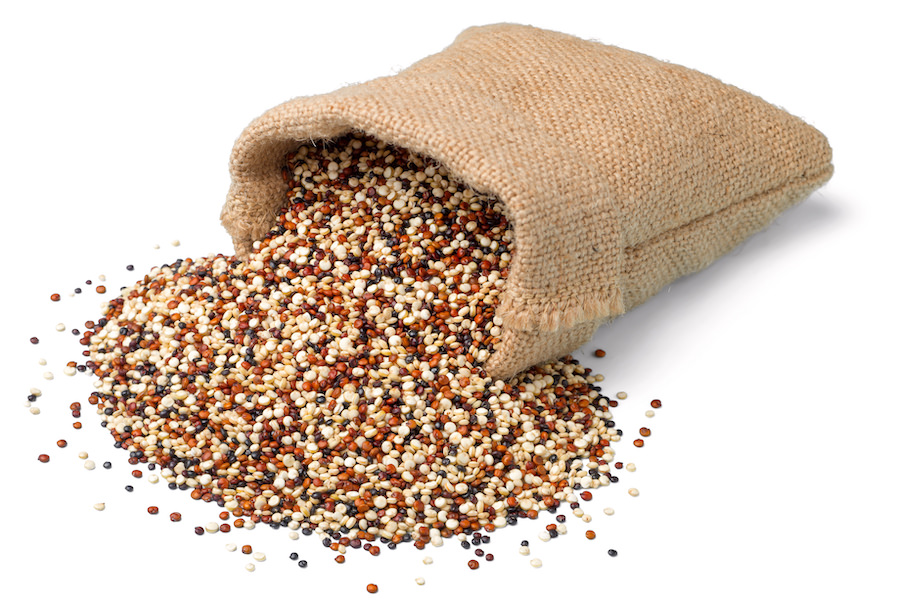
Grains | Calories | Grams of Protein | % of Calories from Protein |
Millet, cooked (1 cup) | 207 kcal | 6.11 g | 11.8% |
Oatmeal, cooked (1 cup) | 166 kcal | 5.94 g | 14.3% |
Pasta, brown rice (2 ounces dry) | 210 kcal | 4 g | 7.6% |
Pasta, quinoa and rice (2 ounces dry) | 207 kcal | 6 g | 11.6% |
Quinoa, cooked (1 cup) | 222 kcal | 8.14 g | 14.7% |
Rice, brown, medium grain, cooked (1 cup) | 218 kcal | 4.52 g | 8.3% |
Rice, white, medium grain, cooked (1 cup) | 242 kcal | 4.43 g | 7.3% |

Fruits, Vegetables, Mushrooms | Calories | Grams of Protein | % of Calories from Protein |
Acorn squash, cooked (1 cup, cubed) | 115 kcal | 2.3 g | 8% |
Apple, red delicious, fresh (1 medium) | 125 kcal | .57 g | 1.8% |
Apricot, fresh (1 medium) | 22 kcal | .2 g | 3.6% |
Apricots, dried (5 medium) | 110 kcal | 1 g | 3.6% |
Artichokes, cooked (1 medium) | 61 kcal | 3.47 g | 23% |
Arugula, raw (1 cup) | 5 kcal | .52 g | 40% |
Asparagus, raw (3 medium spears) | 10 kcal | 1.06 g | 42% |
Asparagus, cooked (3 medium spears) | 10 kcal | 1.08 g | 43% |
Avocado, California (1/2 medium) | 114 kcal | 1.33 g | 4.7% |
Avocado, Florida (1/2 medium) | 182 kcal | 3.39 g | 7.4% |
Bamboo Shoots, cooked (1/4 cup, sliced) | 7 kcal | .92 g | 52% |
Bananas, fresh (1 medium) | 105 kcal | 1.20 g | 4.6% |
Basil, dried (1 teaspoon) | 2 kcal | .16 g | 30% |
Beet, cooked (1 medium) | 22 kcal | .85 g | 15% |
Beet, raw (1 medium) | 35 kcal | 1.32 g | 15% |
Beet greens, raw (1 cup, chopped) | 8 kcal | .84 g | 42% |
Beet greens, cooked (1 cup, chopped) | 39 kcal | 3.7 g | 38% |
Bell pepper, red, raw (1/2 medium) | 15 kcal | .59 g | 16% |
Blackberries, fresh (1 cup) | 62 kcal | 2 g | 13% |
Blueberries, cultivated, fresh (1 cup) | 85 kcal | 1.1 g | 5% |
Blueberries, wild, frozen (1 cup) | 80 kcal | 1 g | 5% |
Bok choy, cooked (1 cup, shredded) | 20 kcal | 2.65 g | 53% |
Boysenberries, frozen (1 cup) | 66 kcal | 1.45 g | 8.7% |
Broccoli, raw (1 cup) | 30 kcal | 2.48 g | 33% |
Broccoli, cooked (1 cup, chopped) | 55 kcal | 3.71 g | 27% |
Broccoli rabe, cooked (1/4 pund) | 25 kcal | 3.83 g | 61% |
Brussels sprouts, cooked, (6) | 45 kcal | 3.21 g | 28.5% |
Burdock root, cooked (1/2 cup, chopped) | 55 kcal | 1.31 g | 9.5% |
Butternut squash, cooked (2 cups, cubed) | 164 kcal | 3.69 g | 9% |
Cabbage, green, cooked (1 cup, shredded) | 34 kcal | 1.91 g | 22.5% |
Cabbage, green, raw (1 cup, shredded | 18 kcal | .9 g | 20% |
Cabbage, red, raw (1 cup, shredded) | 22 kcal | 1 g | 18% |
Carrots, raw (1 medium) | 25 kcal | .57 g | 9% |
Carrots, cooked (1 medium) | 16 kcal | .35 g | 9% |
Cauliflower, cooked (1 cup, 1-inch pieces) | 29 kcal | 2.28 g | 31.4% |
Cauliflower, raw (1 cup, chopped) | 27 kcal | 2.05 g | 30% |
Celeriac, cooked (1 cup, cut up) | 42 kcal | 1.49 g | 14.2% |
Celery, raw (1 medium stalk) | 6 kcal | .28 g | 18.6% |
Celery, cooked (1/2 cup, diced) | 14 kcal | .62 g | 17.7% |
Chard, Swiss, raw (1 cup, chopped) | 7 kcal | .65 g | 37% |
Chard, Swiss, cooked (1 cup, chopped) | 35 kcal | 3.29 g | 37.6% |
Cherries, Bing, fresh (5) | 190 kcal | 1 g | 2.1% |
Chili pepper, hot, green (1) | 18 kcal | .9 g | 20% |
Chives, raw (1 Tablespoon, chopped) | 1 kcal | .1 g | 40% |
Cilantro, raw (1/4 cup, chopped) | 1 kcal | .09 g | 36% |
Coconut, raw (1/4 cup, shredded) | 71 kcal | .67 g | 3.8% |
Coconut, creamed (1 Tablespoon) | 190 kcal | 2 g | 4.2% |
Coconut milk, in carton, unsweetened (1 cup) | 45 kcal | 0 g | 0% |
Coconut milk, in can (1 cup) | 369 kcal | 3 g | 3.3% |
Coconut milk, light, in can (1 cup) | 149 kcal | 0 g | 0% |
Collard greens, cooked (1 cup, chopped) | 63 kcal | 5.15 g | 32.7% |
Collard greens, raw (1 cup, chopped) | 12 kcal | 1.09 g | 36.3% |
Cranberries, dried, sweetened (1/4 cup) | 123 kcal | .07 g | .02% |
Cranberries, fresh (1/4 cup) | 12 kcal | .12 g | 4% |
Cucumbers, fresh (1 small) | 16 kcal | .93 g | 23.3% |
Currants (1/4) | 110 kcal | 2 g | 7.3% |
Daikon radish, cooked (1/2 cup, sliced) | 12 kcal | .49 g | 16.3% |
Dates, Medjool, fresh (2) | 137 kcal | 1 g | 3% |
Dandelion greens, raw (1 cup, chopped) | 25 kcal | 1.49 g | 24% |
Dandelion greens, cooked (1 cup) | 35 kcal | 2.1 g | 24% |
Dulse flakes (1 Tablespoon) | 13 kcal | 1 g | 30.7% |
Eggplant, grilled (4 slices) | 17 kcal | .5 g | 11.8% |
Endive, raw (2 cups, chopped) | 17 kcal | 1.25 g | 29.4% |
Escarole, cooked (1 cup) | 22 kcal | 1.73 g | 31.5% |
Fennel bulb, raw (1 cup, sliced) | 27 kcal | 1.08 g | 16% |
Figs, dried (2) | 42 kcal | .55 g | 5.2% |
Figs, fresh (4 medium) | 148 kcal | 1.5 g | 4% |
Garlic, raw (1 clove) | 4 kcal | .19 g | 19% |
Ginger root, raw (1 teaspoon) | 2 kcal | .04 g | 8% |
Grapefruit, pink or red (1/2 fruit) | 52 kcal | .95 g | 7.3% |
Goji berries, dried (1 Tablespoon) | 20 kcal | .8 g | 16% |
Grapes, seedless red (1-1/2 cups) | 156 kcal | 1.63 g | 4.2% |
Green snap beans, raw (10) | 17 kcal | 1.01 g | 23.7% |
Green snap beans, cooked (1 cup) | 44 kcal | 2.36 g | 21.5% |
Guava, fresh (1 medium) | 37 kcal | 1.4 g | 15.1% |
Hijiki sea vegetable (2 Tablespoons) | 10 kcal | 1 g | 40% |
Honey, raw (1 Tablespoon) | 60 kcal | 0 g | 0% |
Hubbard squash, cooked (1 cup, cubed) | 102 kcal | 5.08 g | 20% |
Kale, cooked (1 cup) | 42 kcal | 3.47 g | 33% |
Kale, raw (1 cup) | 7 kcal | .61 g | 34.9% |
Kiwi, fresh (2) | 90 kcal | 2 g | 9% |
Kombu seaweed (3-inch piece) | 5 kcal | 0 g | 0% |
Kumquats, fresh (1) | 13 kcal | .36 g | 11.1% |
Lettuce, butterhead, Bibb (2 cups, shredded) | 14 kcal | 1.49 g | 42.5% |
Lettuce, green leaf (2 cups, shredded) | 11 kcal | .98 g | 35.6% |
Lettuce, romaine (2 cups, shredded) | 16 kcal | 1.16 g | 29% |
Leeks, cooked (1 cup, chopped) | 32 kcal | .84 g | 10.5% |
Lemon juice, fresh (2 Tablespoons) | 7 kcal | .11 g | 6.2% |
Lime juice, fresh (2 Tablespoons) | 8 kcal | .13 g | 6.5% |
Loquat, raw (1 medium) | 8 kcal | .07 g | 3.5% |
Mango, fresh (1 cup pieces) | 99 kcal | 1.35 g | 5.4% |
Maple syrup (2 Tablespoons) | 104 kcal | .02 g | .1% |
Melon, cantaloupe (2 cups, cubed) | 109 kcal | 2.69 g | 9.9% |
Melon, honeydew (2 cups, diced) | 122 kcal | 1.84 g | 6% |
Molasses, blackstrap (1 Tablespoon) | 60 kcal | 1 g | 6.7% |
Mushrooms, button, cooked (1 cup) | 44 kcal | 3.39 g | 30.8% |
Mushrooms, portobello, cooked (1 cup) | 35 kcal | 3.97 g | 45.4% |
Mushrooms, shiitake, cooked (1 cup) | 81 kcal | 2.26 g | 11.1% |
Mustard greens, cooked (1 cup chopped) | 36 kcal | 3.58 g | 39.8% |
Nori sea vegetable (2 sheets) | 10 kcal | 2 g | 80% |
Okra, cooked (1 cup, sliced) | 35 kcal | 2.99 g | 34.2% |
Onions, cooked (1/4 cup) | 23 kcal | .71 g | 12.3% |
Onions, cooked (1/4 cup) | 16 kcal | .44 g | 11% |
Orange, navel, fresh (1) | 69 kcal | 1.27 g | 7.3% |
Papaya, raw (1 cup pieces) | 62 kcal | .68 g | 4.4% |
Passion fruit, raw, purple (1) | 17 kcal | .4 g | 9.5% |
Peaches, yellow, fresh (1 medium) | 58 kcal | 1.38 g | 9.5% |
Pears, fresh (1 medium) | 101 kcal | .64 g | 2.5% |
Peas, sweet, cooked (1/2 cup) | 70 kcal | 4 g | 22.9% |
Persimmons, fresh (1) | 32 kcal | .2 g | 2.5% |
Pomegranates, fresh (1/2 cup seeds) | 72 kcal | 1.45 g | 8% |
Potatoes, cooked (1 medium) | 144 kcal | 2.86 g | 8% |
Pumpkins, cooked (1 cup, mashed) | 49 kcal | 1.76 g | 14.4% |
Purslane, raw (2 cups) | 17 kcal | 1.75 g | 41.2% |
Raddichio, raw (2 cups, shredded) | 18 kcal | 1.14 g | 25.4% |
Radishes, raw (3 medium) | 2 kcal | .09 g | 18% |
Raspberries, raw (1 cup) | 64 kcal | 1.48 g | 9.2% |
Rutabaga, cooked (1 cup, mashed) | 72 kcal | 2.23 g | 12.4% |
Scallions, raw (1/4 cup, chopped) | 8 kcal | .46 g | 23% |
Snap peas, raw (1 cup) | 53 kcal | 2 g | 15% |
Snow peas, raw (1 cup) | 26 kcal | 1.76 | 27% |
Spaghetti squash, cooked (2 cups) | 84 kcal | 2.05 g | 9.8% |
Spinach, cooked (1 cup) | 41 kcal | 5.35 g | 52.2% |
Spinach, raw (2 cups) | 14 kcal | 1.72 g | 49% |
Sprouts, mung bean (1 cup) | 33 kcal | 4 g | 48% |
Sweet potatoes, cooked (1 cup, mashed) | 249 kcal | 4.49 g | 7.2% |
Tangerines, fresh (1 medium) | 47 kcal | .71 g | 6% |
Taro, cooked (1 cup, sliced) | 187 kcal | .69 g | 1.5% |
Tomatoes, sundried (1/4 cup) | 35 kcal | 1.9 g | 22% |
Tomatoes, fresh (1 medium) | 22 kcal | 1.08 g | 19.6% |
Tomatoes, stewed (1 cup) | 80 kcal | 1.98 g | 9.9% |
Turnip greens, raw (1 cup, chopped) | 18 kcal | .82 g | 18.2% |
Turnips, cooked (1 cup, cubed) | 34 kcal | 1.11 g | 13% |
Water chestnuts, in water (1/2 cup, sliced) | 70 kcal | 1 g | 57% |
Watercress, raw (1 cup, chopped) | 4 kcal | .78 g | .78% |
Yellow squash, cooked (1 cup, sliced) | 34 kcal | 1.87 g | 22% |
Zucchini, cooked (1 cup, sliced) | 27 kcal | 2.05 g | 30.3% |
The terms complete and incomplete are misleading in relation to plant protein. Protein from a variety of plant foods, eaten during the course of a day, supplies enough of all indispensable (essential) amino acids when caloric requirements are met.
Academy of Nutrition and Dietetics
Frequently Asked Questions
Amino acids are the building blocks for protein. There are about twenty amino acids; nine of them are essential, meaning our bodies cannot produce them on their own. These nine essential amino acids need to be provided through our daily diet: histidine, isoleucine, leucine. lysine, methionine, phenylalanine, threonine, tryptophan, and valine.
Animal protein contains all of these essential amino acids making them complete proteins. Some plant foods are also complete proteins – namely quinoa, amaranth, buckwheat, spirulina, hemp seeds, and chia seeds. As a group plant foods provide all of these essential amino acids; however, most individual plant foods are considered incomplete because they don’t contain all nine.
In the 1970s, popular thinking was that vegetarians/vegans needed to be mindful of food combining (think rice and beans) in order to ensure each meal contained the full profile of amino acids. This concept was created by sociologist/activist Frances Moore Lappé, the author of Diet For a Small Planet. However, professionals have long known that the concept of food combining for the purpose of creating complete proteins is a myth. Even Frances Moore Lappé realized her mistake and retracted her statement, but unfortunately this misconception still lingers on. As long as you eat a varied diet with enough calories, you will supply your body with all of these building blocks; they do not have to be eaten in the same meal.
Yes, but as the below graphic illustrates, you would need to eat A LOT of them – every day! The point is, as long as you eat enough calories, you’ll also be eating enough protein. I suggest including the more calorie-dense legumes, whole grains, nuts, and seeds into your daily routine. Doing so is a delicious, varied, and efficient way to consume not only the calories and protein required, but also all of the other macronutrients, micronutrients, and phytonutrients.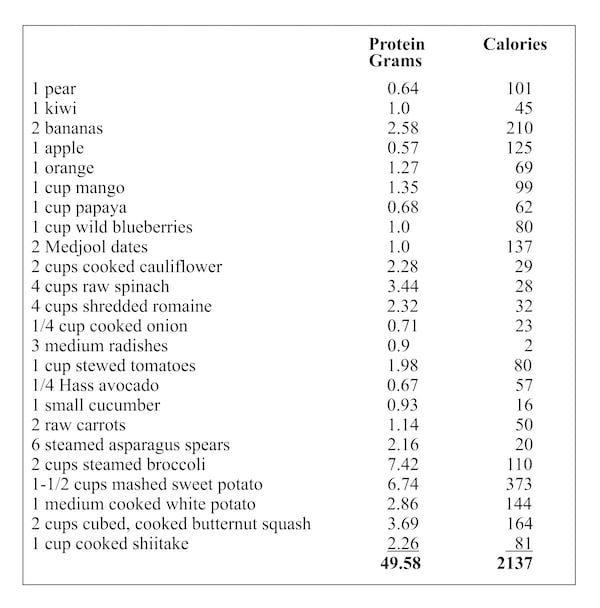
This is not typically a concern in the Western world. It is virtually impossible to become protein deficient unless you are not consuming enough calories, eating only junk foods, or exclusively eating fruit.
There have been many studies correlating excess animal protein with various health concerns including:
• calcium excretion and bone loss
• increased pathogenic microorganisms and higher risk of metabolic diseases
• promotion of tumor growth
• higher incidence of cancer
• increased mortality among those with pre-existing disease
• increased risk of type 2 diabetes
Per the Institutes of Medicine, “It is commonly believed that athletes should consume a higher-than-normal protein intake to maintain optimum physical performance. However, since compelling evidence of additional need is lacking, no additional dietary protein is suggested for healthy adults who undertake resistance or endurance exercise.”
You are capable of getting plenty of protein through your diet, making protein powders unnecessary. All protein powders contain undesirable ingredients such as synthetic vitamins, highly processed food fragments, sweeteners, fillers, and more. They are not natural whole foods. Besides, adding protein powders to your regime will probably result in the consumption of too much protein.
If you enjoyed this post, check out Are Supplements Necessary?
Judy is a certified holistic nutritionist through the American Fitness Professionals & Associates, and earned the plant-based nutrition certificate offered through the T. Colin Campbell Center for Nutrition Studies. She has also studied herbalism, energy healing, and homeopathy. Judy offers many services, always using a common sense yet intuitive approach to wellness.
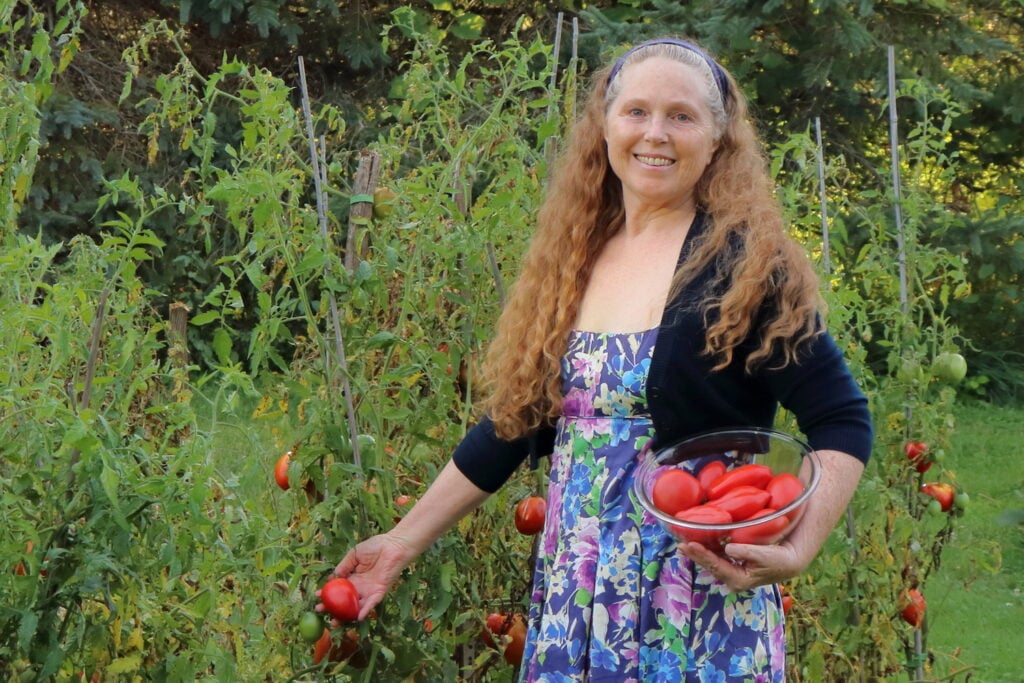

Brilliant! Thank you for making it so clear.
You’re welcome, and thanks for the feedback!
Wow! Thank you for such a well written article. I’m printing it to keep in my favorite vegan cookbook!
You’re very welcome! That’s so sweet of you to say 🙂